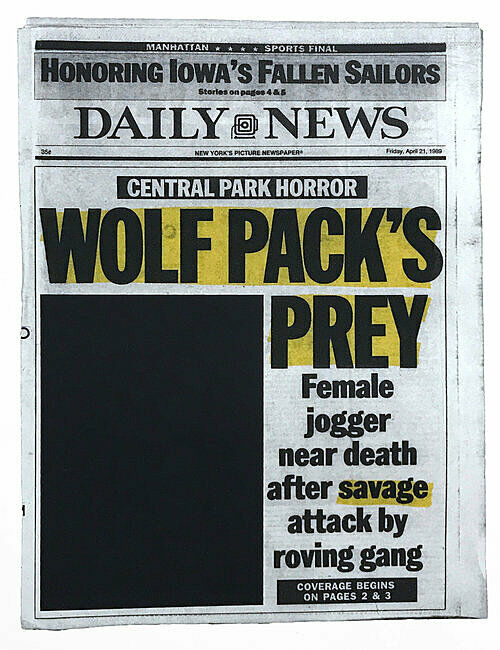Whitney Biennial 2019 | Art & Artists
May 17–Oct 27, 2019
Whitney Biennial 2019 | Art & Artists
Alexandra Bell
6
Floor 5
Born 1983 in Chicago, IL
Lives in Brooklyn, NY
In her prints, Alexandra Bell revisits articles from the New York Daily News that reflect the paper’s coverage of the now infamous 1989 Central Park Five case, in which five innocent teenage boys of color were wrongly convicted of assaulting and raping a white female jogger in Central Park. Bell highlights headlines and body text and redacts photos to draw attention to latent failings in journalistic objectivity, and to interrogate how journalism can perpetuate racialized violence through language.
The title of Bell’s series refers to a 1994 essay by critical theorist Sylvia Wynter, No Humans Involved, in which the writer responds to a radio report on the riots that followed the 1992 acquittal of four Los Angeles police officers who brutally beat an unarmed Rodney King. According to that report, public officials in the city routinely used the acronym NHI—“no humans involved”—to describe cases involving young Black men like King.
Friday, April 21, 1989 - Front Page, 2019, from the series No Humans Involved: After Sylvia Wynter, 2018-2019
-
0:00
Alexandra Bell
0:00
Alexandra Bell: I'm Alexandra Bell.
The work looks at ten days of reporting about the Central Park Five case, in which a white investment banker was attacked and raped in Central Park. The cops rounded up a number of young boys, and of those, five were convicted of her rape and attempted murder, in some cases. They all served between six and thirteen years in prison. About twelve years into their serving time, a young man came forward, Matias Reyes, to say that he committed the crime, so they were released.
Highlighting and redacting are two critical techniques to my practice. I'm really trying to figure out how to force the viewer’s eye into particular information. In this particular series, I use blackout to cover up images, to cover up text that really focuses on the victim [at the time]. I want to reorient the viewer around the idea of the victim and thinking about these young boys as also victims.
While there are twenty pages shown here, I think overall there were maybe up to forty pages worth of coverage within those ten days on this particular case. And this is before a trial, before anybody is found guilty. The repetitious nature is really important to the framework, especially if you consider that during that same period of time, the week that the Central Park jogger was attacked, there were over twenty-five other rapes, majority of those Black and Latino women, that weren't reported.
It's meant to tire the reader in a way. Also, there's so many elements that show up over and over again. The question that I'm hoping will stick with people is why so much attention to it? For me, it's a racial one, but I don't know if that's what the viewer would pick up.

